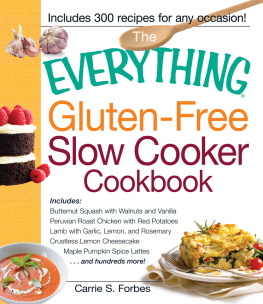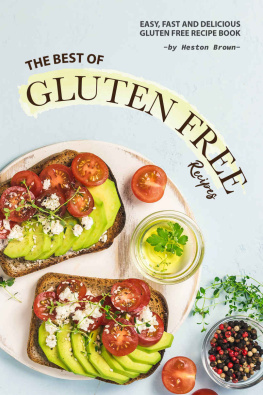THE

LOW-GLYCEMIC
COOKBOOK
Carrie S. Forbes

Avon, Massachusetts
To Michael: Because Ive always, always been sure of you. To LeeEllen: For listening to all my renditions of Puff the Magic Dragon and never turning down an opportunity to watch Law & Order. I love you both!
Contents
Introduction
Over the years, an endless number of fad diets have come and gone. The Grapefruit Diet, the HCG Diet, the Cabbage Soup Diet, the Hollywood Diet, the Atkins Diet, the 17 Day diet, the Zone Diet, the South Beach Diet, the Blood Type Diet, and the list goes on and on. Nearly all of these diets can be effective if they are followed strictly, but the problem is sticking to them. Most people can follow these diets well for a week or two, but they will fall off the wagon because of the rigid food restrictions, and consequently feel bad about it.
Thats why the low-glycemic diet is so great. It is not so much a diet as a more balanced way of eating. As long as you dont have any food allergies or dietary restrictions due to circumstances like celiac disease, you can basically eat whatever you want. You simply learn how to limit when you can have foods considered high-glycemic and for the majority of your meals and snacks to eat more foods that are lower on the glycemic index and therefore are digested more slowly in the body. However, even with the food restrictions of celiac disease or wheat allergies, eating low glycemic isnt nearly as restrictive as most fad diets.
The concept of a low-glycemic diet has been around since the mid-1960s and was originally created for patients with diabetes. At the time, some doctors believed a diet that was focused on a well-rounded food plan, paying close attention to the type of carbohydrates being consumed, would help patients have better control over their blood sugar levels. Carbohydrates are categorized as either simple or complex. Simple carbohydrates are foods such as table sugar (sucrose), milk sugar (lactose), or fruit sugar (fructose). Complex carbohydrates, which are molecularly more elaborate and harder to digest, include vegetables, whole grains, and beans. In 1981, researchers David Jenkins and Thomas Wolever of the University of Toronto Department of Nutritional Sciences created and established the Glycemic Index and published a study that suggested that using this system would be a much more accurate way of classifying carbohydrates for diabetes patients.
Since the glycemic index was developed, dozens of low-carb diets have emerged. Many of the diets are based on similar science and theory as the Low-Glycemic diet, such as the Sugar Busters Diet, the Zone Diet, the Protein Power Diet, and even the South Beach Diet.
In 1997 Walter Willett, an epidemiologist and nutritionist, did further research and helped to create glycemic load, an even more accurate way to measure or rate carbohydrates in comparison to the glycemic index. Glycemic load takes into consideration the amount of food eaten, where the glycemic index does not. For example, popcorn has an overall glycemic index of 72, which is considered high, yet a serving of two cups only has 10 net carbs (overall carbohydrates minus the fiber content) and a glycemic load of 7, which is considered quite low. So when you are creating meals and planning menus, keep in mind the glycemic load of individual servings and not just the glycemic index of foods. Each recipe in this book will tell you where the dish ranks on the glycemic index to help you make great choices.
The recipes in this book are also gluten-free. This may not appeal to everyone who needs to follow a low-glycemic diet, but most of the recipes are naturally gluten-free, meaning you dont have to buy special ingredients to make them. The majority of recipes in this book call for healthful whole ingredients such as vegetables, meats, chicken, and eggs, and some include dairy such as shredded cheese, milk, or a milk substitute (such as almond milka great choice for those who are intolerant to dairy proteins). All of these ingredients are naturally gluten-free, making them safe for a wider variety of people. So you may be eating many gluten-free foods already without even realizing they are gluten-free. That is the goal of this bookto provide healthy, delicious low-glycemic recipes that everyone can enjoy.
CHAPTER 1
The Glycemic Index
The glycemic index (GI) is an effective tool for managing weight and controlling blood sugar levels. In the following sections you will learn how to successfully use this tool in daily meal planning. Knowing how to select low GI foods is the first step. This cookbook provides delicious recipes to help you achieve your health and wellness goals. This book also focuses on recipes that are gluten-free for those who need a low-glycemic diet, have celiac disease, a wheat or gluten intolerance, or just wish to follow a paleo-type diet. A paleo-type diet is a diet that basically imitates the nutritional choices of our hunter-gatherer ancesters. The Paleo diet consists of eating whole foods including animal proteins, fresh vegetables and fruits, high-quality fat sources (such as coconut oil, olive oil, and avocados), and nuts and seeds.
What Is the Glycemic Index?
The glycemic index is a simple and valuable tool that can be used to help choose the right carbohydrate foods to keep blood sugar levels stable. It is a numerical index that ranks foods based on their glycemic response in the body. Lower GI foods are more slowly digested and absorbed and, therefore, produce gentler fluctuations in blood sugar and insulin levels. Higher glycemic index foods cause a quicker rise in blood sugar and insulin. Knowing how to choose the right carbohydrate foods, plan balanced meals, and select the right portion sizes are the keys to weight control, disease prevention, and overall good health.

Eating controlled portion sizes is a basic part of any healthful eating plan, and a low-glycemic diet is no exception. Remember, when youre using the glycemic index, it is best followed when you eat reasonable serving sizes at meals and as snacks. These amounts are listed in the Glycemic Index Value Table at the end of the chapter.
The glycemic index levels of foods are determined by tests performed in clinical settings. The scientists feed human test subjects a determined portion of the test food and then draw and test samples of their blood at specific intervals. The test subjects blood sugar response to a carbohydrate food is compared to the blood sugar response to an equal portion of pure glucose. Glucose, which has a GI level of 100, is the reference food for GI testing. For example, if the subjects are given orange juice, and it raises their blood sugar level only 50 percent as much as pure glucose, orange juice is given a glycemic index level of 50. Based on its GI level, a food can be assigned to one of three GI categories:
- Low GI: 55 or less
- Moderate GI: 5669
- High GI: 70 or more
Its healthful to eat a wide variety of low-glycemic foods while minimizing high-glycemic foods. Each recipes nutritional statistics include its glycemic index level to help you plan your days meals.















